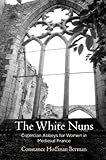The White Nuns : Cistercian Abbeys for Women in Medieval France / Constance Hoffman Berman.
Material type: TextSeries: The Middle Ages SeriesPublisher: Philadelphia : University of Pennsylvania Press, [2018]Copyright date: ©2018Description: 1 online resource (368 p.) : 21 illusContent type:
TextSeries: The Middle Ages SeriesPublisher: Philadelphia : University of Pennsylvania Press, [2018]Copyright date: ©2018Description: 1 online resource (368 p.) : 21 illusContent type: - 9780812295085
- Abbeys -- France -- History -- To 1500
- Cistercian convents -- France -- History -- To 1500
- Cistercian nuns -- France -- History -- To 1500
- Monasticism and religious orders for women -- France -- History -- To 1500
- HISTORY / Medieval
- Gender Studies
- History
- Medieval and Renaissance Studies
- Religion
- Religious Studies
- Women's Studies
- 271/.97 23
- online - DeGruyter
| Item type | Current library | Call number | URL | Status | Notes | Barcode | |
|---|---|---|---|---|---|---|---|
 eBook
eBook
|
Biblioteca "Angelicum" Pont. Univ. S.Tommaso d'Aquino Nuvola online | online - DeGruyter (Browse shelf(Opens below)) | Online access | Not for loan (Accesso limitato) | Accesso per gli utenti autorizzati / Access for authorized users | (dgr)9780812295085 |
Browsing Biblioteca "Angelicum" Pont. Univ. S.Tommaso d'Aquino shelves, Shelving location: Nuvola online Close shelf browser (Hides shelf browser)

|

|

|

|

|

|

|
||
| online - DeGruyter Strange Bedfellows : Marriage in the Age of Women's Liberation / | online - DeGruyter Governing Bodies : American Politics and the Shaping of the Modern Physique / | online - DeGruyter Risk and Ruin : Enron and the Culture of American Capitalism / | online - DeGruyter The White Nuns : Cistercian Abbeys for Women in Medieval France / | online - DeGruyter Blood Matters : Studies in European Literature and Thought, 14-17 / | online - DeGruyter Human Rights in Thailand / | online - DeGruyter Between Christ and Caliph : Law, Marriage, and Christian Community in Early Islam / |
Frontmatter -- contents -- Preface -- PART I. WERE THERE CISTERCIAN NUNS IN MEDIEVAL EUROPE? -- Chapter 1. Reform Monasticism and Cistercian Nuns in Western Europe -- Chapter 2. Visitation of Nuns and Their Regularization -- Chapter 3. Cistercian Nuns and the Order’s Economic Practices -- PART II. CISTERCIAN NUNS IN THE ECCLESIASTICAL PROVINCE OF SENS -- Chapter 4. Women Regents, Cistercian Nuns, and Feudal Crisis: Clairets, Villiers, Voisins, and Port-Royal -- Chapter 5. Cistercian Nuns and the Great Heiresses of Chartres, Blois, and Auxerre -- Chapter 6. Blanche of Castile (1188–1252) and Cistercian Abbeys for Nuns -- Chapter 7. Saint-Antoine-des-Champs Outside Paris -- Chapter 8. Nuns and Viticulture in Champagne -- PART III. COMPARISONS AND CONCLUSIONS -- Chapter 9. Cistercian Nuns and Their Predecessors -- Appendix 1. Ad Medium, Amortissement, Augmented Rents, Measures, Money, Names -- Appendix 2. The Evidence: Cistercian Nuns’ Charters and Charter Books -- Appendix 3. Specific Charters and Other Materials for This Study -- Appendix 4. Size Limits of Abbeys for Cistercian and Other Nuns -- Appendix 5. Numbers of Cistercian Nuns’ Houses According to Selected Historians -- Notes -- Bibliography -- Index -- Acknowledgments
restricted access online access with authorization star
http://purl.org/coar/access_right/c_16ec
Modern studies of the religious reform movement of the central Middle Ages have often relied on contemporary accounts penned by Cistercian monks, who routinely exaggerated the importance of their own institutions while paying scant attention to the remarkable expansion of abbeys of Cistercian women. Yet by the end of the thirteenth century, Constance Hoffman Berman contends, there were more houses of Cistercian nuns across Europe than of monks. In The White Nuns, she charts the stages in the nuns' gradual acceptance by the abbots of the Cistercian Order's General Chapter and describes the expansion of the nuns' communities and their adaptation to a variety of economic circumstances in France and throughout Europe. While some sought contemplative lives of prayer, the ambition of many of these religious women was to serve the poor, the sick, and the elderly.Focusing in particular on Cistercian nuns' abbeys founded between 1190 and 1250 in the northern French archdiocese of Sens, Berman reveals the frequency with which communities of Cistercian nuns were founded by rich and powerful women, including Queen Blanche of Castile, heiresses Countess Matilda of Courtenay and Countess Isabelle of Chartres, and esteemed ladies such as Agnes of Cressonessart. She shows how these founders and early patrons assisted early abbesses, nuns, and lay sisters by using written documents to secure rights and create endowments, and it is on the records of their considerable economic achievements that she centers her analysis.The White Nuns considers Cistercian women and the women who were their patrons in a clear-eyed reading of narrative texts in their contexts. It challenges conventional scholarship that accepts the words of medieval monastic writers as literal truth, as if they were written without rhetorical skill, bias, or self-interest. In its identification of long-accepted misogynies, its search for their origins, and its struggle to reject such misreadings, The White Nuns provides a robust model for historians writing against received traditions.
Mode of access: Internet via World Wide Web.
In English.
Description based on online resource; title from PDF title page (publisher's Web site, viewed 04. Okt 2022)


